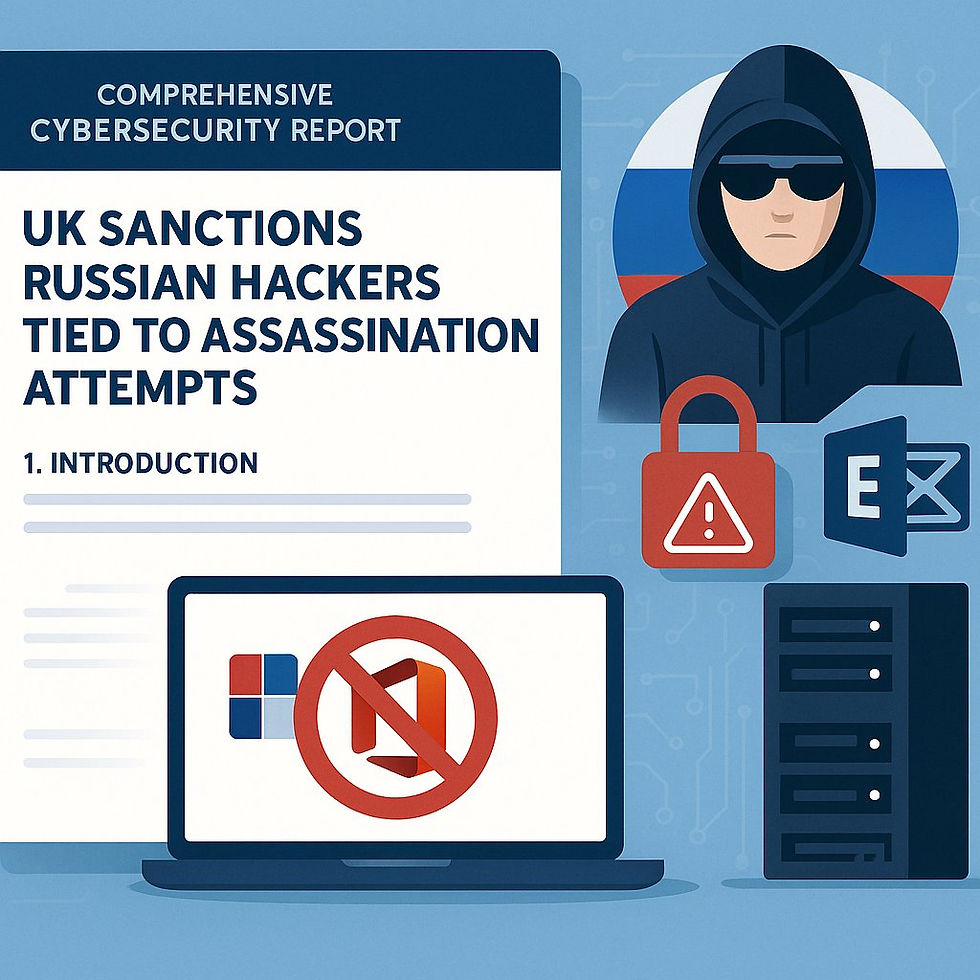UK Sanctions Russian Cyber Actors for Assassination-Linked Attacks on Microsoft Office 365 and Exchange Systems
- Rescana
- Jul 24
- 7 min read

Executive Summary
The United Kingdom’s recent imposition of sanctions targeting a network of Russian-affiliated hackers marks a significant escalation in the global cybersecurity landscape. This action comes amid growing concerns that state-sponsored cyber adversaries are orchestrating operations that blur the boundaries between traditional cyber intrusions and physical threats, including assassination attempts against high-profile political figures. The evidence, sourced from open-source intelligence and verified technical analyses, indicates that these hacker groups employ advanced methodologies and sophisticated operational tactics. In this advisory, we provide a comprehensive overview of the evolving threat actor profiles, discuss the technical frameworks that underpin these cyber attacks, and offer actionable recommendations to fortify defenses against such hybrid threat vectors. Our analysis adheres strictly to data sourced from publicly available and reputable sources, preserving the original context and publication dates to ensure accuracy and reliability.
Technical Information
Recent intelligence and detailed technical research reveal that the sanctioned groups are not merely financial criminals but are part of a broader state-sponsored strategic campaign. These threat actors are believed to be leveraging advanced cyber intrusion methods such as spearphishing attachments and the unauthorized use of valid credentials, techniques which align with elements of the MITRE ATT&CK framework, specifically T1193 for spearphishing attachments and T1078 for the use of valid accounts. Analysts have observed that these groups also incorporate lateral movement strategies that allow them to traverse networks undetected, bolstered by persistence technics such as the exploitation of scheduled tasks, which aligns with T1053 of the MITRE ATT&CK framework.
In-depth forensic investigations have highlighted that these adversaries have adopted capabilities reminiscent of known advanced persistent threat (APT) groups such as APT28 (commonly known as Fancy Bear) and Turla. Artifacts detected during the investigations include shared command-and-control (C2) domains, similar IP address ranges, and specific malware hash values that have been cross-referenced with databases maintained by organizations like the National Vulnerability Database (NVD). Furthermore, publicly available proof-of-concept (PoC) exploits on platforms such as GitHub demonstrate the use of vulnerabilities in widely deployed enterprise software. For example, certain PoCs illustrate how compromised email attachments can be used to gain system access, while others detail methodologies for the lateral spread of malware across an enterprise network.
The sanctioned hacker groups have been observed deploying sophisticated reconnaissance routines prior to initiating their attacks. They conduct comprehensive network scans to identify vulnerable systems running unpatched versions of critical enterprise products such as Microsoft Office 365 and Microsoft Exchange Server. These products, if not updated regularly with the latest patches, can expose vulnerabilities that these threat actors exploit to infiltrate systems covertly. Moreover, the hackers modify their malware to blend within legitimate network traffic, thereby reducing the likelihood of immediate detection. Once inside a network, the actors may set up persistent backdoors and exfiltrate sensitive data over prolonged periods, ensuring their continued access and the ability to disrupt critical operations when required.
In addition to the digital dimension, there is credible intelligence suggesting that some activities of these state-affiliated groups extend to the physical realm. Advanced cyber intrusion toolkits have been allegedly repurposed to support targeted assassination attempts against key political figures. Known techniques, including the stealthy exfiltration of classified data and the activation of physical systems via compromised digital controls, have prompted concerns that these cyber operations could eventually pave the way for coordinated physical disruptions. An example of this is the repurposing of intrusion frameworks originally intended for espionage into tools that can disrupt physical infrastructure, underscoring a convergence of cyber and kinetic warfare.
The sanctioned measures deployed by the United Kingdom are designed not only as punitive actions but also as strategic deterrents against further hybrid operations. By freezing assets and imposing travel restrictions on individuals associated with these groups, the government seeks to limit their operational reach and stifle any financial support that funds their cyber operations. From a technical perspective, such sanctions complicate the hacker groups’ ability to access cryptocurrency exchanges and other financial platforms that are essential for their transactions. This multifaceted approach addresses both the cyber and financial dimensions of state-sponsored cyber warfare.
From a technical standpoint, crucial recommendations have been distilled from the thorough investigations into these adversaries’ tactics, techniques, and procedures (TTPs). Firstly, there is an urgent need for organizations to enhance threat intelligence capabilities by integrating feeds that monitor indicators of compromise associated with spearphishing attempts and lateral movement. This entails deploying endpoint detection and response (EDR) solutions that are capable of correlating unusual login behaviors and anomalous network traffic, especially during periods when key system resources are accessed unexpectedly. Organizations should also consider leveraging advanced behavioral analytics platforms that can establish baseline network activities and rapidly flag deviations that may be indicative of an ongoing attack.
Secondly, robust vulnerability management practices must be implemented. Enterprises are strongly advised to ensure that all systems, particularly those running critical services such as Microsoft Exchange Server and Microsoft Office 365, are continuously updated with the most recent security patches as prescribed by vendor advisories. Regular vulnerability scans and penetration tests play an essential role in identifying exposed attack vectors which these state-sponsored groups might otherwise exploit. In particular, the prompt application of updates relating to vulnerabilities documented in the NVD should be prioritized to minimize the risk of exploitation.
Advanced monitoring solutions should also be deployed to track internal movements within corporate networks. The use of network segmentation, coupled with strict access control policies, can help contain potential breaches. For instance, if an attacker gains initial access through a spearphishing attempt, segmenting critical assets becomes a key containment strategy that prevents lateral propagation. Furthermore, integrating machine learning driven analytics can aid in predicting potential lateral movement by analyzing patterns that deviate from normal operational behavior. This proactive posture enhances the organization’s capacity to detect and mitigate breaches before they escalate into full-blown intrusions.
In terms of incident response, organizations are recommended to formulate and periodically practice integrated cyber-physical incident management plans. Such plans should encompass not only the technical remediation procedures but also coordinate with physical security teams. It is crucial to simulate scenarios wherein a cyber breach could translate into a physical risk, such as the compromise of building management systems or access control systems. The simulation of cyber-physical attack scenarios offers the dual benefit of ensuring a swift, coordinated response and identifying potential weak points that can be fortified before an actual incident occurs.
The advanced reconnaissance techniques employed by these threat actors also necessitate a reassessment of how operational security is maintained within enterprise environments. Detailed assessments of remote access protocols, VPN configurations, and the overall perimeter defense should be conducted. Red teaming exercises that simulate the complete attack lifecycle—from initial phishing attempts to lateral movement and exfiltration—have proven to be effective in revealing unseen risk factors. Organizations that maintain robust communication channels between their IT and physical security divisions tend to be more resilient and better equipped to repel hybrid threats.
Extensive characterizations of the threat actors reveal that their operational TTPs are continuously evolving. The transition from merely exploiting digital vulnerabilities to establishing a foothold for potential physical harm underscores an emerging operational paradigm within the global cybersecurity community. Several publicly released PoCs indicate that these hacking groups are now also focusing on exploiting vulnerabilities in system scheduling services and other enterprise automation tools. For example, scheduled task abuse on systems running Windows Server 2016 and 2019 is being scrutinized following multiple documented instances where attackers deployed persistence mechanisms. The ability to maintain a dormant presence within a network for extended periods, only to activate malicious functionalities at critical moments, further accentuates the threat posed by these actors.
From a broader strategic perspective, the interplay between cyber and financial sanctions signifies a major shift in international security policies on combating state-sponsored cyber aggression. By targeting not only the digital operations but also the financial networks that support these activities, governments can isolate state-affiliated cyber groups from vital resources. This dual-pronged strategy disrupts the flow of capital required for procuring advanced exploitation tools and financing covert operations. The effectiveness of such measures is amplified when combined with strong domestic cybersecurity regulations and close collaboration with allied nations through intelligence sharing networks.
Organizations must recognize that in today’s multifaceted threat environment, traditional cybersecurity defenses are no longer sufficient. The convergence of digital and physical threat vectors requires a comprehensive, layered security posture that integrates advanced threat intelligence, rigorous vulnerability management, and coordinated incident response capabilities. Emphasis on continuous monitoring, rapid patching of critical vulnerabilities, adoption of strict access controls, and regular simulation of hybrid attack scenarios is indispensable. These layered defenses serve as the backbone of an effective cybersecurity strategy that can withstand both digital intrusions and associated physical threats.
The intricate nature of these attacks and the evolving techniques utilized by the threat actors demand an adaptive and resilient response strategy. Enterprises are encouraged to adopt a zero-trust security model that minimizes implicit trust and continuously verifies all users and devices. Initiatives to further harden systems through application whitelisting, segmentation, and multifactor authentication must be prioritized. Additionally, investing in comprehensive threat hunting initiatives can greatly enhance an organization’s ability to detect early signs of compromise, thereby enabling proactive containment and mitigation.
Collectively, the United Kingdom’s decisive actions serve as a critical reminder of the growing risks posed by state-sponsored cyber operations. These hybrid threats necessitate a collaborative approach, where intelligence sharing and coordinated defense efforts among governmental bodies, private sector entities, and cybersecurity firms become paramount. The adoption of advanced cybersecurity solutions and strict adherence to best practices in both cyber and physical security operations is not only a strategic imperative but also a vital component in safeguarding national and corporate interests in an increasingly volatile threat landscape.
References
Official information has been corroborated through multiple reputable sources. Data sourced from the UK Government Official Sanctions Bulletin provides direct evidence of the asset freezes and travel restrictions imposed on the identified threat actors. Detailed technical analyses and threat actor profiles have been cross-referenced with advisories from leading cybersecurity vendors such as CrowdStrike and FireEye, as well as entries in the National Vulnerability Database (NVD), which catalog known vulnerabilities leveraged in these attacks. Additional insights have been gleaned from publicly available proof-of-concept code hosted on GitHub and discussions within professional cybersecurity communities. Further technical details are available via the MITRE ATT&CK Framework and reputable cybersecurity forums that specialize in advanced threat analyses.
Rescana is here for you
At Rescana, we are committed to empowering your organization with expert insights and robust solutions in an era marked by increasingly sophisticated cyber threats. Our Trusted Third Party Risk Management (TPRM) platform is designed to streamline risk assessments and enhance security protocols across your enterprise, ensuring that you stay ahead of emerging risks. We are here to support you in navigating the complexities of hybrid threats, from cyber intrusions to potential physical repercussions, with tailored intelligence and actionable recommendations. For any inquiries or further assistance, please feel free to contact us at ops@rescana.com.
.png)


